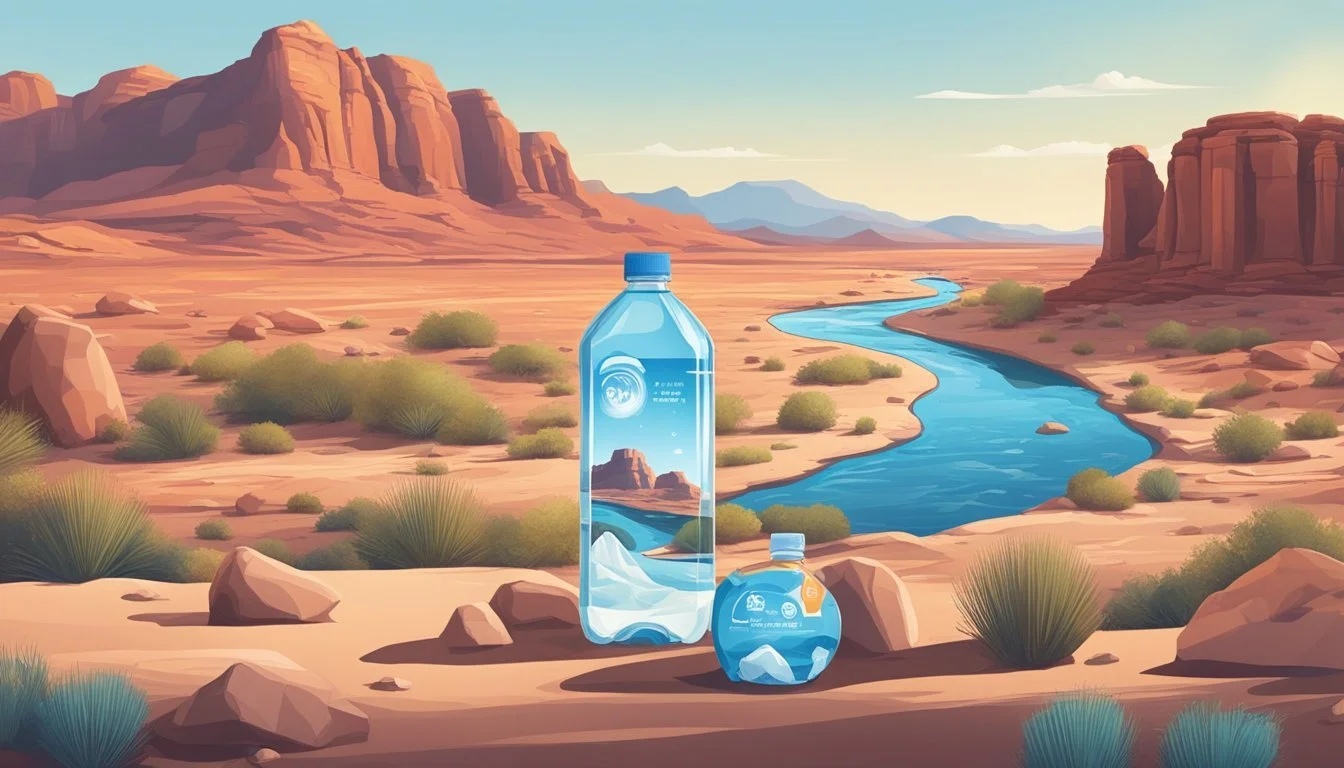Purely Sedona vs. Open Water
Comparing Quality and Taste
Choosing the right bottled water can significantly impact your hydration experience. In the comparison between Purely Sedona and Open Water, both brands offer unique features that appeal to different consumer needs. For those prioritizing taste and mineral content, Purely Sedona emerges as a preferred choice due to its naturally sourced, crisp profile.
Open Water offers an eco-friendly alternative with its commitment to sustainability. Packaged in recyclable aluminum, it caters to environmentally conscious consumers who want their hydration choice to align with their green values. Both brands excel in different areas, making the decision largely dependent on personal preferences and priorities.
Whether it's the luxurious mineral taste of Purely Sedona or the sustainable packaging of Open Water, consumers have excellent options to choose from. The following comparative analysis will help you determine which brand best suits your needs.
Evaluating Water Quality and Purity
When selecting between Purely Sedona and Open Water, two crucial aspects to consider are water quality and purity. These factors are influenced by the source of the water, purification processes, and the presence of minerals or contaminants.
Determining Factors of Purity
Purity in bottled water is assessed primarily by the absence of contaminants. Brands like Purely Sedona and Open Water test for substances including toxic PFAS chemicals, bacteria, and heavy metals.
Purely Sedona, known for its emphasis on local heritage, claims its water is sourced from pristine locations, ensuring minimal contamination. Open Water, marketed as a sustainable choice, often undergoes rigorous filtration processes to remove any impurities.
Consumers should review water quality reports for detailed assessments of their chosen brands.
Impact of Source on Quality
The source of water greatly influences its quality. Purely Sedona sources its water from natural springs, believed to impart a unique mineral composition essential for taste and health benefits.
Open Water often utilizes aquifers, tapping into deep groundwater reserves that are naturally filtered through geological layers. These sources typically offer water that is free from surface pollutants.
Understanding the source can give insights into the natural purity and the potential mineral benefits of the water being consumed.
Total Dissolved Solids (TDS) Content
Total Dissolved Solids (TDS) content measures the combined content of all inorganic and organic substances present in the water.
For Purely Sedona, higher TDS levels might indicate a rich mineral water profile, beneficial for those seeking specific nutrients. Tests have shown it to be slightly acidic, particularly in its sparkling variant.
Open Water generally maintains a balanced pH level and a moderate TDS content, providing a cleaner taste preferred by some consumers.
By comparing TDS values, consumers can determine the type of water that best suits their health needs and preferences. The balance between mineral content and purity usually dictates the final choice.
Health Benefits and Considerations
Purely Sedona and Open Water offer various health benefits that are influenced by their mineral content, alkalinity, and electrolyte balance. Understanding these aspects can help in selecting the best option for individual health needs.
Mineral Content and Health Benefits
Purely Sedona boasts a rich mineral profile, featuring calcium, magnesium, and bicarbonates. Calcium is essential for bone health, while magnesium supports muscle function and digestion. These minerals contribute to the overall health benefits of the water.
Open Water, on the other hand, focuses on purity with minimal mineral content. This makes it suitable for those looking to reduce their intake of specific minerals. While it lacks the mineral density of Purely Sedona, its clean profile is ideal for users who prefer their water free from additives.
Alkalinity and pH Level
Purely Sedona presents an alkaline pH, which can help neutralize acid in the body and support overall health. An alkaline pH is believed to aid in reducing acid reflux and improving metabolic functions.
Open Water maintains a neutral pH balance, closer to what is naturally found in the body. This neutrality makes it versatile for daily consumption and suitable for people with neutral alkaline level preferences. While it may not provide the same acid-neutralizing benefits, it ensures balanced consumption.
Hydration and Electrolyte Balance
Purely Sedona contains key electrolytes such as potassium and magnesium, essential for maintaining hydration and electrolyte balance. These elements play critical roles in muscle function and overall cellular health.
Open Water, highlighting its purity, does not enhance with electrolytes. This aspect might be a consideration for athletes or individuals requiring additional electrolytes for performance. Nevertheless, its pure nature ensures it meets basic hydration needs efficiently without added elements.
Both water brands offer distinct health benefits. The choice between them depends on personal preferences for mineral content, pH level, and specific hydration requirements.
Taste and Aesthetic Experience
Comparing the taste and aesthetic experience of Purely Sedona and Open Water highlights their distinct flavor profiles, packaging designs, and consumer preferences.
Flavor Profile Comparison
Purely Sedona is known for its robust and crisp flavor, making it a refreshing choice for those who prefer a stronger taste. This brand boasts a unique mineral composition that contributes to its distinctive taste.
On the other hand, Open Water offers a smooth and subtle flavor, aiming to deliver a fresh drinking experience without overpowering the palate. The difference in taste largely depends on the mineral content and the source of the water.
Aesthetic and Packaging Influence
Purely Sedona features elegant, high-quality glass bottles that underscore its premium status. The design is sleek, focusing on a clean and sophisticated appearance that appeals to aesthetic-conscious consumers.
Open Water, packaged in recyclable aluminum cans, emphasizes sustainability. Their minimalist approach not only supports environmental concerns but also appeals to those who appreciate modern, eco-friendly packaging. The aesthetic choices by each brand play a significant role in shaping the consumer's perception and experience.
Consumer Preferences and Brand Loyalty
Consumers of Purely Sedona often cite brand loyalty due to its premium taste and elegant presentation. This loyalty is strengthened by the brand's commitment to providing a luxurious drinking experience.
Open Water has garnered a loyal following among eco-conscious buyers who value its smooth taste and sustainable packaging. Consumer preference for Open Water is driven by its environmental commitment and the freshness of the water.
In summary, the choice between Purely Sedona and Open Water hinges on individual taste preferences, packaging appeal, and personal values regarding sustainability. Each brand caters to different aspects of the bottled water experience, from taste to aesthetics.
Source and Origin Stories
Purely Sedona and Open Water have distinct sources that influence their taste and quality.
Mythical and Healing Properties
Purely Sedona Water is sourced from a registered spring in Oak Creek Canyon, Arizona. This region is renowned for its pristine environment, contributing to the water's natural filtration. Users appreciate its alkalinity and the eco-friendly packaging. The spring’s remoteness ensures that the water remains uncontaminated, providing a pure drinking experience.
Open Water, on the other hand, does not specify a single source but emphasizes sustainability in its packaging. While it may not have the rustic origin of Purely Sedona, its appeal lies in eliminating plastic waste. For comparison, brands like Evian and San Pellegrino source from the French Alps and Italian springs respectively, underlining a heritage of quality and purity.
Note: Always cross-check the sustainability claims and ensure that the information provided aligns accurately with environmental standards for genuine quality assurance.
Environmental and Production Efforts
Purely Sedona and Open Water have implemented numerous sustainability practices. Their efforts focus on minimizing plastic waste, using alternative materials for bottles, and reducing their overall carbon footprint.
Sustainability Practices
Purely Sedona emphasizes local sourcing and minimal processing to enhance sustainability. They partner with regional suppliers and focus on transparent supply chains.
Open Water sets itself apart by committing to carbon neutrality. They actively invest in renewable energy projects and employ water stewardship initiatives.
Both brands engage in eco-friendly practices but differ in their approaches. Purely Sedona follows a more localized, community-centered model, while Open Water takes a global, future-focused perspective.
Bottles: Plastic Waste and Alternatives
Purely Sedona primarily offers water in glass bottles. This choice significantly reduces plastic waste but comes with higher production energy costs.
Open Water uses 100% recyclable aluminum cans, eliminating single-use plastics almost entirely. They also support recycling programs that aim to minimize landfill contributions.
Boxed Water, another key player, uses cartons made from renewable resources. This option has become popular among eco-conscious consumers.
These varied approaches highlight ongoing efforts within the industry to address plastic waste through innovative packaging solutions.
Carbon Footprint of Water Brands
The production process for bottled water releases CO2, impacting the environment. Pure Life, Deer Park, and Ice Mountain are known for their detailed annual sustainability reports, which often include carbon footprint metrics.
Purely Sedona and Open Water both work on reducing their emissions. Purely Sedona has focused more on offsetting emissions locally, while Open Water champions larger, global offset projects.
Brands like Zephyrhills and Lifewtr also provide transparency in their carbon footprint data, showing a commitment to reducing impact.
Comparative studies reveal that brands prioritizing sustainability can effectively decrease CO2 emissions, demonstrating the positive impact of conscious production practices in the bottled water industry.
Cost and Accessibility Comparisons
Understanding the costs and accessibility of Purely Sedona and Open Water can help consumers choose the most suitable bottled water option for their needs. This section examines pricing strategies, market availability, and the comparison between tap water and bottled alternatives.
Pricing Strategy Analysis
Purely Sedona positions itself as a budget-friendly choice within premium bottled waters. Prices generally range from $1.50 to $3.00 per bottle. This makes it accessible to a wider audience, including cost-conscious buyers, without compromising on purity and quality.
Open Water, an eco-friendly brand, emphasizes sustainable packaging, which can influence its pricing. Typically, Open Water bottles cost between $2.00 and $4.00 each. Despite being slightly more expensive, many consumers are willing to pay for its commitment to reducing plastic waste.
A table comparing the prices:
Brand Price Range per Bottle Purely Sedona $1.50 - $3.00 Open Water $2.00 - $4.00
Market Availability
Purely Sedona leverages local heritage and is primarily available in regions known for spring water, making it a popular local choice. It’s often found in regional supermarkets and specialty stores.
Open Water, driven by its eco-conscious appeal, has a broader market presence. It is widely available in major national retailers and online platforms. This ease of access, combined with its packaging innovation, makes it convenient for a more extensive audience.
Both brands can be purchased online, broadening their reach beyond physical store limitations.
Comparing Tap Water and Bottled Alternatives
Tap water offers a cost-effective and readily available alternative to bottled water. On average, tap water costs a fraction of a cent per gallon, making it the most economical option. However, concerns over water quality and taste variations can make bottled water more appealing.
Purely Sedona and Open Water focus on providing purified, clean-tasting water, differentiating themselves from brands like Aquafina, Core Hydration, and Smartwater. While tap water undergoes treatment, the purification processes in premium bottled water remove impurities, ensuring consistency.
Consumers seeking a balance between cost and convenience often weigh these factors carefully, choosing bottled water for its perceived superior quality and taste consistency. Comparing costs, accessibility, and personal priorities can guide the best choice for hydration needs.
Comparative Analysis of Purely Sedona and Open Water
Both Purely Sedona and Open Water are premium bottled water brands that cater to different aspects of health and sustainability preferences. Purely Sedona emphasizes local heritage and affordability, whereas Open Water focuses on eco-friendly packaging and sustainability.
Distinct Features of Purely Sedona
Purely Sedona offers a premium bottled water experience rooted in local heritage. Its marketing emphasizes purity, with details pointing to its origins in Sedona, Arizona. The brand positions itself as a more budget-friendly option, with prices ranging from $1.50 to $3.00 per bottle, making it accessible to a broader audience.
The water undergoes a rigorous quality control process. It includes both still and sparkling options. Notably, the sparkling version has been noted for its acidity, appealing to those who prefer a tangy taste.
Unique Qualities of Open Water
Open Water distinguishes itself with a strong focus on sustainability. It uses 100% recyclable aluminum bottles, which significantly reduce plastic waste. This eco-friendly packaging resonates with environmentally conscious consumers. The brand's commitment to sustainability is further evidenced by its efforts to offset carbon emissions.
Open Water is sourced from natural springs, ensuring a clean and crisp taste. It offers both still and sparkling options, catering to different preferences. The pricing is competitive within the premium segment, reflecting its dual focus on quality and environmental responsibility.
Head-to-Head Brand Comparison
Price and Accessibility:
Purely Sedona: $1.50 - $3.00 per bottle.
Open Water: Relatively more expensive, reflecting its sustainable packaging.
Sourcing and Taste:
Purely Sedona: Local heritage, sourced from Sedona; both still and sparkling, with sparkling being acidic.
Open Water: Natural springs, ensuring a clean and crisp flavor; both still and sparkling.
Packaging:
Purely Sedona: Traditional plastic bottles.
Open Water: Eco-friendly, 100% recyclable aluminum bottles.
Market Positioning:
Purely Sedona: Budget-friendly, broad audience appeal.
Open Water: High-end, eco-friendly, targets environmentally conscious consumers.
The choice between Purely Sedona and Open Water ultimately depends on individual priorities, whether it's cost-effectiveness and heritage, or sustainability and modern packaging. Both brands offer unique benefits within the premium bottled water market.
Conclusion
When comparing Purely Sedona and Open Water, several factors can help guide the decision.
Water Source:
Purely Sedona sources its water from a registered spring, ensuring a natural taste and mineral content. Open Water, known for its sustainable approach, typically sources water that is purified to meet safety standards.
Safety:
Both brands prioritize safety. Purely Sedona ensures its spring water undergoes rigorous testing, while Open Water utilizes advanced purification processes to ensure contaminant-free water.
Purified vs. Spring Water:
Purely Sedona offers naturally sourced spring water. Open Water focuses on purified water, giving consumers a choice based on their preferences for natural mineral content versus purity.
Still and Sparkling Options:
Purely Sedona primarily offers still and sparkling spring water. Open Water caters predominantly to those seeking still purified water. Despite this, both brands deliver crisp and refreshing options.
Environmental Considerations:
Open Water emphasizes sustainability with its recyclable aluminum packaging, reducing plastic waste. Purely Sedona also pays attention to environmental impact but doesn't emphasize it as a core selling point.
In choosing between Purely Sedona and Open Water, consider what aspects matter most: the source, safety, type (still or sparkling), and environmental footprint. Both brands provide high-quality hydration solutions suited to different preferences and needs.








